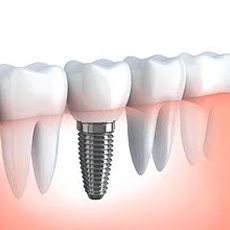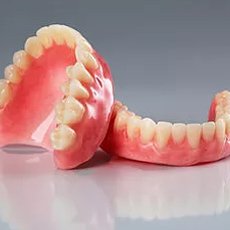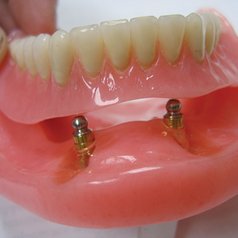


Dental Services |
 As the name suggests, Dental bridges literally bridges the gap caused by missing teeth one or more. A bridge comprises of two or more crowns for the teeth on either side of the gap. These two anchoring teeth are called abutment (supporting) teeth -- and false tooth/teeth are placed in between. As per our Dental bridges are supported by natural teeth or implants.
As the name suggests, Dental bridges literally bridges the gap caused by missing teeth one or more. A bridge comprises of two or more crowns for the teeth on either side of the gap. These two anchoring teeth are called abutment (supporting) teeth -- and false tooth/teeth are placed in between. As per our Dental bridges are supported by natural teeth or implants.
Bridges can:
Restore your smile
Restore the ability to properly chew and speak
Protects yourtemporomandibular joint
Maintain the shape of your face
Distribute the forces in your bite properly by replacing missing teeth
Prevent remaining teeth from drifting out of position
Restore your confidence
What Is the Process for Getting a Dental Bridge as per our best dentist?
During the first visit for getting a dental bridge, the abutment teeth are prepared. Preparation involves shaping these teeth by removing a portion of enamel to allow space for a crown to be placed over them. Next, impressions of the teeth are made, which serve as a model on which the bridge is fabricated. Your best dentist will make a temporary bridge to wear to protect the exposed teeth and gums while the bridge is being made.
During the subsequent visit, your temporary bridge will be removed and the new porcelain or metal bridge will be checked and adjusted, as necessary, to achieve a proper fit. Multiple visits may be required to check the fit of the metal framework and bite. This is dependent on each individual's case. If the dental bridge is a fixed bridge, your dentist may temporarily cement it in place for a couple of weeks to make sure it is fitting properly. Later on, the bridge is cementedinto place.
 Keyhole Dental Implants :
Keyhole Dental Implants :
Why one should'nt ignore missing teeth?
What is the procedure of Single Tooth Replacement Procedure?
What is the "look & feel" and life of Keyhole Dental Implants?
Why one should'ntignore missing teeth?
Losing multiple teeth from decay, gum disease or neglect will have a domino effect resulting in bone loss around your remaining teeth causing them to become loose, rotated and mobile. Don't be complacent just because your missing teeth are in the back of your mouth! To avoid the risk of cascading harm to neighbouring teeth, your lost teeth should be replaced as soon as possible with implants.
What is the procedure of Single Tooth Replacement Procedure?
The procedure is relatively simple. A small hole is precisely drilled into the bone at the location of the missing tooth. A small titanium implant is placed into the prepared site. The implant is allowed to heal for 4-5 months. During this time, you can wear a temporary tooth replacement. You won't even know the implant is there. After healing is complete, the implant is uncovered and the final crown is placed.
Dental implants look, feel and function like natural teeth, and can last a lifetime.
Years ago if you lost a single tooth, a fixed bridge was your only option. The teeth on each side of the missing tooth were ground down and prepared for crowns, the missing tooth was connected to the crowns and the fixed bridge was cemented to place. Now, thanks to advances in modern dentistry, a dental implant may be the best, strongest and simplest way for you to replace that missing tooth. The teeth on each side of the space no longer need to be destructed and prepared for crowns. The implant looks, feels and functions like the natural tooth it replaces. The result is esthetically pleasing, remarkably strong and durable, and surprisingly economical. Ask us for more details about single tooth replacements with dental implants.
 Benefits of Dentures
Benefits of Dentures
Prevents existing teeth from drifting into surrounding space of the missing teeth. Helps to chew food Can't it be made before 6-8 weeks of healing? It can be made but the fit of the denture may reduce once healing is complete. You may then have to refit the denture or get a new one done.
How long to wait after tooth extraction for dentures? Usually a period of 6-8 weeks of healing is recommended before dentures are made.
Types of Dentures
Complete Dentures :
Complete dentures or Full dentures are used when all the teeth are missing. Complete dentures can be either "conventional" or "immediate". The framework of complete dentures may be made of plastic/resin, metal or a combination. Implant supported overdentures are an alternate to conventional dentures whereby a full denture is placed over the dental implants with metal bar/balls that gives better retention. Partial Dentures : Partial dentures are used when some natural teeth remain. A removable partial denture usually consists of replacement teeth attached to a pink or gum-colored plastic base, which is connected by metal clasps or precision attachments that holds the denture in place in the mouth. Precision attachments are generally more esthetic than metal clasps as they are nearly invisible.
Immediate Dentures :
Immediate dentures are made in advance and can be positioned as soon as the teeth are removed. As a result, the wearer does not have to be without teeth during the healing period. However, bones and gums shrink over time, especially during the healing period following tooth removal therefore immediate dentures would usually require more adjustments to fit properly during the healing process and generally should only be considered a temporary solution until conventional dentures can be made after the healing process as it can take months for your bone and tissue to stabilize after tooth extractions.
 Modify Existing Dentures with Implants : In many cases, your existing denture can be modified to this system and will fit your new dental implants, saving you the expense of an entirely new denture.
Modify Existing Dentures with Implants : In many cases, your existing denture can be modified to this system and will fit your new dental implants, saving you the expense of an entirely new denture.
One popular option has the stability of a fixed denture, but with the convenience of a removable denture. The denture will not move or disengage from the dental implants with regular movements such as eating or speaking but can be easily removed whenever necessary. When you need to remove your denture, you just apply pressure in a lifting motion with your thumbs, and your denture pops off the dental implants easily.
We recommend people dentures consider having them secured by dental implants able to withstand chewing forces and hold your denture firmly in place. In fact, implant supported dentures will restore nearly 95% of your chewing ability!
Reduced need for bone grafting. The special tilting of two of the implants ensures a secure and stable anchorage for the replaced arch, typically making bone grafting unnecessary.
Faster treatment and healing time. Your replacement arch can be attached to your implants immediately after insertion.
Scientifically proven and documented. All-on-4 is supported by good clinical outcomes from studies over a decade with favorable results.
Designed by Seacom Digital